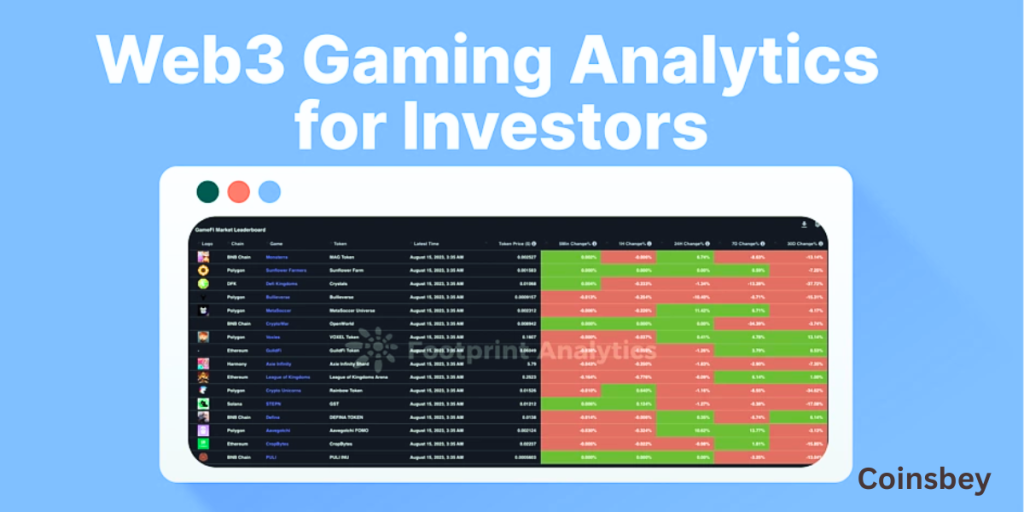What is Web3 gaming analytics and why is it important for investors?

Web3 gaming analytics refers to the collection, analysis, and interpretation of data related to gaming activities on Web3 platforms. Web3 gaming refers to games built on blockchain technology, utilizing decentralized networks and cryptocurrencies.
Web3 gaming analytics provides valuable insights into player behavior, game performance, and overall market trends. It encompasses various metrics such as player engagement, retention, in-game transactions, virtual asset trading, and community interactions. These analytics enable investors to make informed decisions by understanding the dynamics of the Web3 gaming ecosystem.
Here are a few reasons why Web3 gaming analytics is important for investors
- Blockchain Gaming: Web3 gaming refers to games built on blockchain technology, where in-game assets and transactions are recorded on a decentralized ledger. This provides transparency and ownership to players, making it an attractive investment option.
- NFTs (Non-Fungible Tokens): Many Web3 games use NFTs to represent unique in-game assets like skins, characters, or items. Investors can analyze the NFT marketplaces and trading volumes to gauge the popularity of a game and its potential for growth.
- Player Activity: Monitoring the number of active players, daily transactions, and engagement metrics within a Web3 game can help investors assess its user base and potential for long-term sustainability.
- Tokenomics: Understanding the tokenomics of a Web3 game is crucial. This includes the total supply of tokens, their distribution, and how they are used within the game ecosystem. Investors should evaluate how the tokens’ value may appreciate over time.
- Game Development Team: Assess the reputation and experience of the development team behind the Web3 game. A strong team with a track record of successful projects can be a positive sign for potential investors.
- Community and Social Engagement: Web3 gaming communities are often active on social media platforms and forums. Monitoring community sentiment and engagement can provide insights into a game’s popularity and potential.
- Economic Models: Analyze the economic models of Web3 games, including revenue generation through token sales, play-to-earn mechanics, and incentives for players. Evaluate if these models are sustainable and profitable.
- Security and Smart Contracts: Ensure that the game’s smart contracts are secure and audited to minimize the risk of hacks or exploits, which can impact the value of in-game assets and tokens.
- Regulatory Considerations: Stay informed about the regulatory environment surrounding Web3 gaming in your jurisdiction. Regulations can impact the legality and taxation of investments in this space.
- Diversification: As with any investment, it’s important for investors to diversify their portfolio to manage risk. Web3 gaming should be considered as a part of a broader investment strategy.
- Long-Term Perspective: Web3 gaming investments may require a longer time horizon. It’s important to be patient and not solely focus on short-term gains.
To access specific analytics and data for Web3 games, investors can use various crypto and blockchain analytics platforms, explore gaming communities and forums, and follow industry news to stay up-to-date with the latest developments in the Web3 gaming space.
- How does Web3 gaming analytics differ from traditional gaming analytics?
- What are some common metrics used in Web3 gaming analytics?
- How can Web3 gaming analytics be used to improve game design?
- What are the benefits of using Web3 gaming analytics for investors compared to traditional gaming analytics?
How does Web3 gaming analytics differ from traditional gaming analytics?
Web3 gaming analytics, also known as blockchain gaming analytics, differs from traditional gaming analytics in several key ways:
- Transparency: Web3 gaming analytics leverages the transparency and immutability of blockchain technology. All game-related data, including player actions, transactions, and item ownership, are recorded on the blockchain, ensuring transparency and eliminating the possibility of data manipulation.
- Ownership and Interoperability: Web3 gaming analytics focuses on analyzing player ownership and interactions with in-game assets that are stored on the blockchain. Unlike traditional gaming analytics, where ownership of in-game assets is controlled by the game developer, Web3 games enable true ownership and interoperability of assets across different games and platforms. This allows for more comprehensive analysis of player behavior and engagement.
- Decentralization: Web3 gaming analytics operates on decentralized networks, such as Ethereum, where game logic and data are distributed across multiple nodes. This decentralization ensures that game data cannot be controlled or manipulated by a single entity, providing a higher level of trust and security.
- Tokenomics and Economy: Web3 gaming analytics places a strong emphasis on analyzing the in-game economy and tokenomics. In Web3 games, players can earn and trade in-game tokens or cryptocurrencies, which have real-world value. Analyzing player behavior in relation to tokenomics provides insights into the game’s economy, player motivations, and potential monetization strategies.
- Community-driven Metrics: Web3 gaming analytics takes into account community-driven metrics, such as player-driven content creation, user-generated assets, and social interactions within the game ecosystem. These metrics are often crucial for understanding the health and growth of Web3 games, as they reflect the level of engagement and involvement of the player community.
In summary, Web3 gaming analytics differs from traditional gaming analytics by leveraging blockchain technology for transparency, enabling true ownership and interoperability of in-game assets, operating on decentralized networks, analyzing tokenomics and the in-game economy, and considering community-driven metrics.
What are some common metrics used in Web3 gaming analytics?
In Web3 gaming analytics, several common metrics are used to measure the success and performance of games. Here are some of the key metrics:
- Daily Active Users (DAU): This metric measures the number of unique users who engage with the game on a daily basis. It helps gauge the game’s popularity and user engagement.
- Monthly Active Users (MAU): Similar to DAU, MAU measures the number of unique users who interact with the game over a month. It provides a broader view of user engagement and retention.
- Retention Rate: This metric measures the percentage of users who continue to play the game over a specific period. It helps assess the game’s ability to retain players and indicates the game’s stickiness.
- Average Revenue Per User (ARPU): ARPU measures the average revenue generated by each user. It helps evaluate the game’s monetization strategy and the effectiveness of in-game purchases or other revenue streams.
- Conversion Rate: This metric measures the percentage of users who convert from free players to paying customers. It provides insights into the game’s ability to convert users into paying users and the effectiveness of the monetization model.
- Churn Rate: Churn rate measures the percentage of users who stop playing the game over a specific period. It helps assess user retention and the game’s ability to keep players engaged.
- Average Session Length: This metric measures the average duration of a gaming session. It provides insights into user engagement and the overall gameplay experience.
- Virality: Virality measures the extent to which users share the game with others. It helps assess the game’s reach and potential for organic growth through word-of-mouth.
- User Acquisition Cost (UAC): UAC measures the cost associated with acquiring new users. It helps evaluate the efficiency of marketing and user acquisition strategies.
- Network Activity: In Web3 gaming, network activity metrics such as transaction volume, gas fees, and the number of NFT trades can provide insights into the game’s ecosystem and the level of user engagement.
These metrics can help game developers and publishers understand user behavior, identify areas for improvement, and make data-driven decisions to optimize the gaming experience and drive growth
How can Web3 gaming analytics be used to improve game design?
Web3 gaming analytics refers to the use of data analysis and insights in decentralized gaming platforms to improve game design. Here are a few ways in which Web3 gaming analytics can be used to enhance game design:
Player Behavior Analysis: Web3 gaming platforms can collect and analyze data on player behavior, such as in-game actions, transactions, and interactions with other players. This data can provide valuable insights into player preferences, play patterns, and engagement levels. Game designers can use this information to identify popular features, optimize gameplay mechanics, and create more engaging experiences.
Economy Balancing: In Web3 games, virtual economies are often driven by blockchain-based assets and cryptocurrencies. Analytics can help monitor the in-game economy, track the supply and demand of virtual assets, and identify imbalances or bottlenecks. By understanding the economic dynamics, game designers can make informed decisions about adjusting item prices, introducing new features, or implementing scarcity mechanics to maintain a healthy and balanced economy.
User Feedback and Sentiment Analysis: Web3 gaming platforms can leverage user feedback and sentiment analysis tools to gather player opinions, suggestions, and sentiments about the game. By analyzing this data, game designers can gain insights into player satisfaction, identify pain points, and understand the overall sentiment towards specific features or updates. This feedback can guide the iterative design process, allowing developers to make data-driven decisions to improve the game.
Smart Contract Analysis: In Web3 gaming, smart contracts govern various aspects of gameplay, such as rewards, achievements, and in-game interactions. Analytics can be used to monitor the performance and effectiveness of these smart contracts. By analyzing contract execution data, game designers can identify potential vulnerabilities, optimize contract logic, and ensure fair and secure gameplay.
Community Engagement: Web3 gaming platforms often have active communities of players who are deeply involved in the game’s development and governance. Analytics can help understand community engagement levels, track user-generated content, and identify influential players or community leaders. Game designers can use this information to foster community-driven initiatives, gather feedback, and involve the community in the game design process.
By leveraging Web3 gaming analytics, game designers can gain valuable insights into player behavior, preferences, and sentiment, enabling them to make data-driven decisions and continuously improve the game design to meet player expectations.
What are the benefits of using Web3 gaming analytics for investors compared to traditional gaming analytics?
Web3 gaming analytics offer several benefits for investors compared to traditional gaming analytics:
- Transparency: Web3 gaming analytics are based on blockchain technology, which provides a transparent and immutable record of all transactions and gameplay. This transparency allows investors to verify the accuracy of the data and ensure that they are making informed decisions.
- Decentralization: Web3 gaming analytics are decentralized, meaning that they are not controlled by any single entity or organization. This eliminates the risk of data manipulation or bias, which is a common concern with traditional gaming analytics.
- Incentivization: Web3 gaming analytics often use token incentives to encourage players to participate in the game and provide data. This creates a self-sustaining ecosystem that generates valuable data for investors.
- Interoperability: Web3 gaming analytics can be easily integrated with other blockchain-based applications and platforms, allowing investors to access a wider range of data and insights.
Overall, Web3 gaming analytics offer investors a more transparent, decentralized, and incentivized approach to gaming analytics, which can help them make more informed investment decisions

